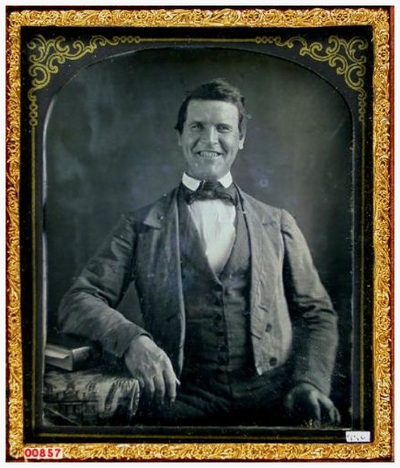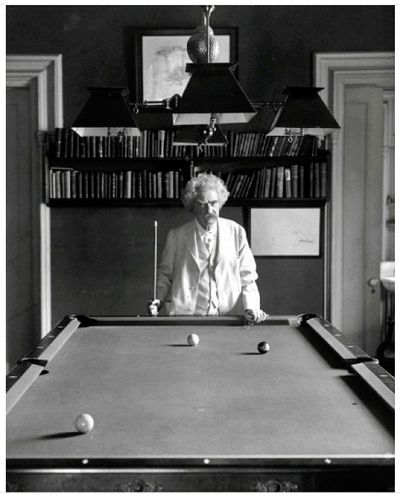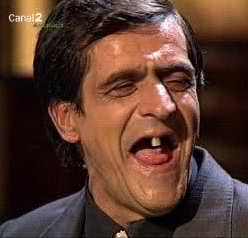This article at The Atlantic will explain it. Short version: they thought it made them look like idiots. Mark Twain: "A photograph is a most important document, and there is nothing more damning to go down to posterity than a silly, foolish smile caught and fixed forever."
Sure enough, I can't think of a single photograph of him with a smile on his face. Not even while he was engaged in a certain enjoyable and relaxing pastime which I am not allowed to talk about.
There's another great quote in the article (the one that starts, "By the 17th century...), but I'm not going to steal all their thunder.
Mike
(Thanks to Jeffrey Goggin)
Original contents copyright 2013 by Michael C. Johnston and/or the bylined author. All Rights Reserved. Links in this post may be to our affiliates; sales through affiliate links may benefit this site.
(To see all the comments, click on the "Comments" link below.)
Featured Comments from:
Richard Tugwell: "This is why."
Mick Ryan: "I'm inclined to ask why people must always be smiling in modern day portraits. It's actually kind of weird."
Steve Jacob: "I think it's no coincidence that the phrase 'say cheese' came about. It is indeed very cheesy most of the time. After all, the 'smile' is the standard tactic of salesmen, ad-men and politicians, and to me it has a whiff (or is that a stink) of insincerity about it.
"Quite apart from bad teeth, bags under the eyes and wrinkles—all of which are heavily accentuated—when people are asked to smile without genuine amusement, it shows. Far from making people look 'friendly and approachable,' a contrived smile will make you look smug, shifty, gormless, or fake. Only a few people I know have a genuinely attractive smile in photographs. Smiles are not a major feature of famous portrait artists that I know. It's certainly not something that Jane Bown or Annie Leibovitz did often. So from the fine art point of view, I don't see that anything has changed much."
Mike replies: Funny, I used to be a portraitist, and almost none of my portraits were of people smiling more than simply looking pleasant, except in groups. And you're right, when I think of great portraits it seems to me that toothsome smiles are actually quite rare.
I'm trying to think of great contemporary portraitists and names aren't springing to my mind. But I found this: Best Portraits from TIME 2012, and out of 43 portraits really only Mitt Romney is smiling, although the expressions of Egyptian President Mohamed Morsi and possibly the first one of Warren Buffet could be argued to constitute "smiles" as well, although neither show teeth. (Some of Gabi Douglas's friends are smiling, although she isn't and she's the subject of the pictures.)
It would be interesting to put together a gallery of excellent contemporary portraits and see how smiles figure in them. Maybe this isn't an historical phenomenon at all, but merely a characteristic of serious portraiture. No pun intended.
Slobodan Blagojevic: "My American contacts on LinkedIn vs. European ones. Yes, I cherry-picked for emphasis, and yes, there are opposite examples on both sides, but the gist remains:
"To paraphrase a joke about Germans, smiling is no laughing matter for Europeans, apparently."
Ivor: "Long exposure notwithstanding, this gentleman manages what I find to be quite a sincere smile in his 1850 Daguerreotype portrait:

"An explanation for the seriousness in most early photographic portraits, that I prefer, was given in a presentation by an archivist at Kodak. He speculated that, in the era before Mr. Eastman introduced mass market cameras, subjects would have been aware that the portrait would, in all likelihood, be the sole record of their likeness. I don’t recall the archivist’s name but I do remember that he complained that decades of looking at portraits of now deceased and mostly unidentified people had become deeply disturbing to him. Perhaps he would have found the portraits less distressing if more of the subjects had looked a little happier."
Mike replies: That portrait is purported to be a Daguerreotype from the 1850s, from the Daguerreian Society's Julian Wolff Collection. But I couldn't verify it. The identification and date should be taken therefore with a grain of salt; it could be a later tintype. His clothing might be the best means of settling on a likely date. I'm no expert on that...although, curiously, I just ran across a remaindered book at the bookstore about 1800s clothing fashions as seen in old Daguerreotypes.
That sense of dread at looking at dead, forgotten people in old photographs is the subject of Michael Lesy's 1973 cult classic Wisconsin Death Trip.
struan: "Darwin's book The Expression of the Emotions in Man and Animals makes it plain that actual smiles and laughter were interpreted in the early photographic era in much the same way they are today. The photographs in the book (by Rejlander, of all people) also show that photography of fleeting expressions was perfectly possible at the time. It seems clear that they are absent from most photographic portraits because they were perceived as inappropriate for formal portraiture.
"When not trying to project an impression of authority or respectability, smiles did crop up. This collection of Victorian theatre portraits has both the confident, welcoming smiles of the man-as-best-friend, and the light smile and downward eyes of the woman-trying-to-be-pleasant. Neither would be out of place in contemporary portraiture, even if not favoured by current art standards.
"You also find smiles in drawings and sketches, but not in finished portraits. Holbein, Ingres, and John Singer Sargent are canonical examples. Finally, children have long been pictured smiling. I am particularly fond of portraiture by painters and photographers depicting their own families and children. One favourite which breaks so many rules and yet works wonderfully is 'Little Suzanne' by Carl Larsson."
[Anonymous]: "We Europeans do smile...
richardpeters: "I like Dave Sailer's very apt reference to 'rictus.' A smile, to be taken as genuine or infectious, has to be a smile 'in the moment' with some evident cause or mood—however tenuous—that we can empathise with. Otherwise we start to feel as creeped-out and unsafe as with the Joker from Batman. Inappropriately-fixed smiling starts out puzzling; eventually, we can't help reading it as either idiocy, or some obsessive and malign travesty on genuine feeling. Not at all convivial, anyway.
"Here's an ancient mask from Mothia, Sicily: part of what little the Romans failed to obliterate of the culture of Carthage. Arresting, deliciously creepy, no?






